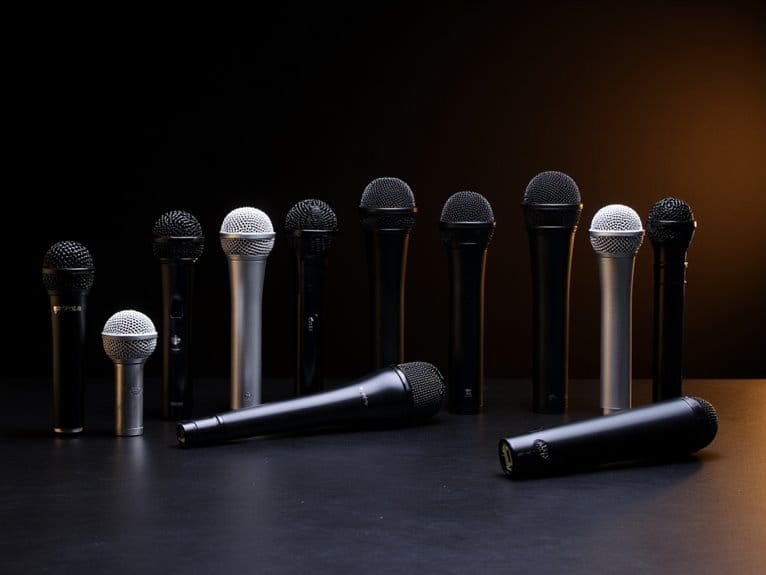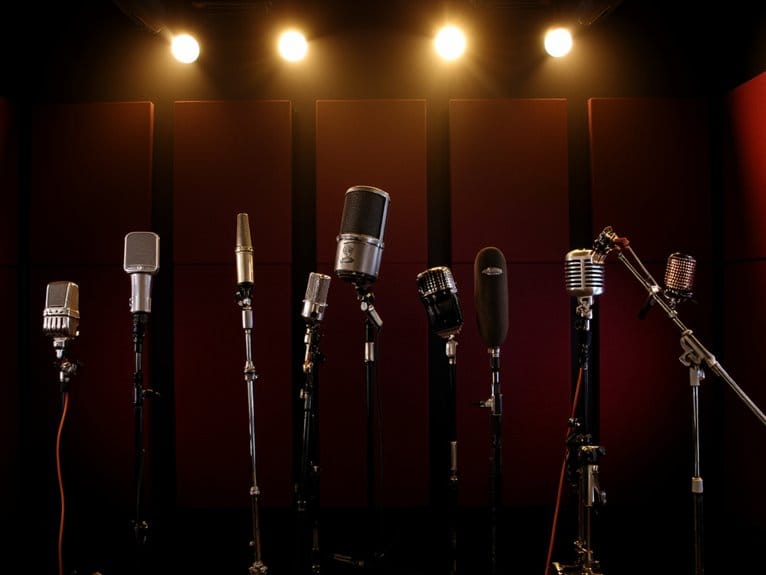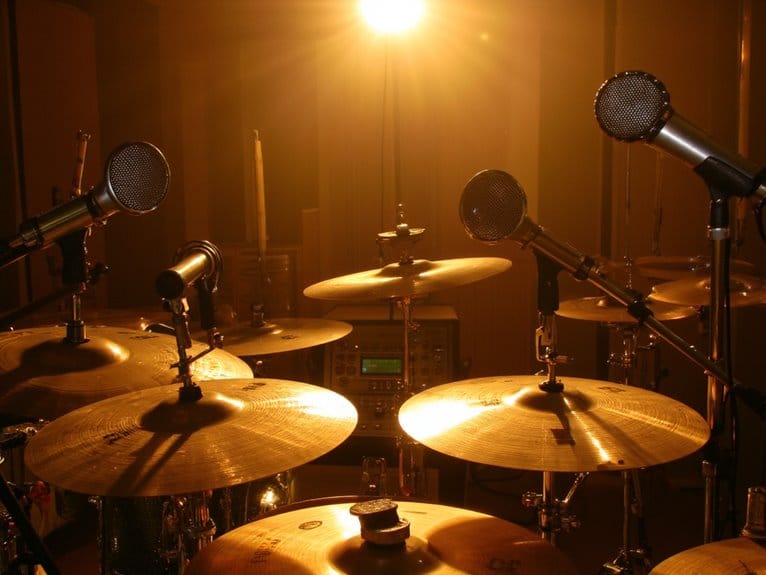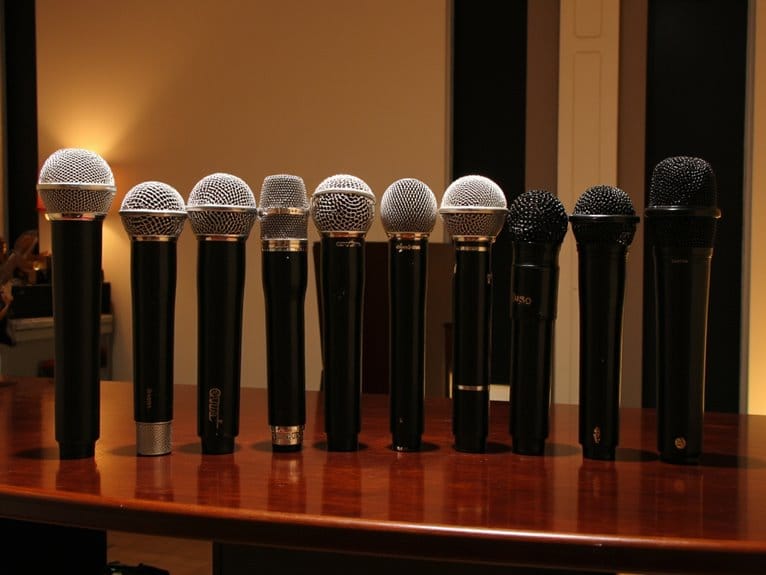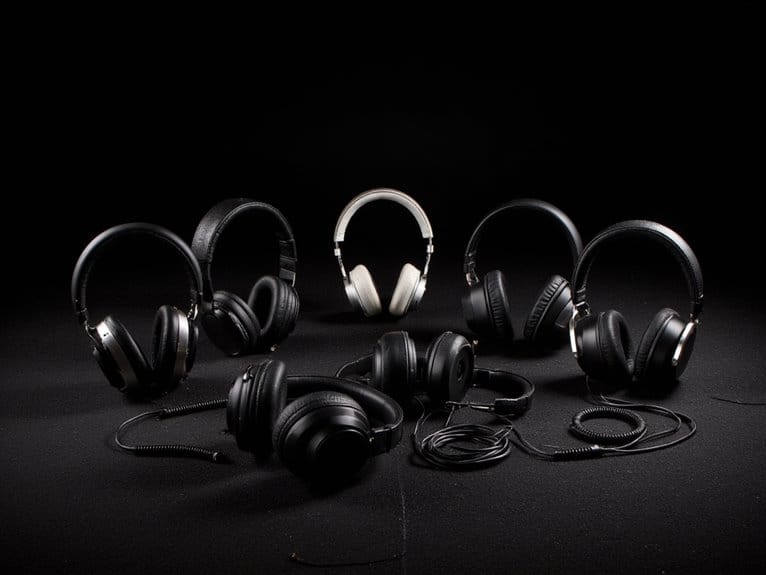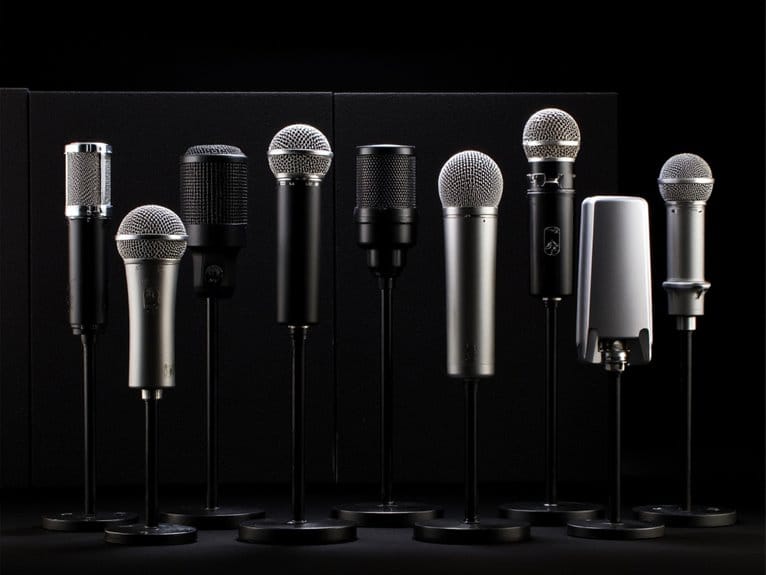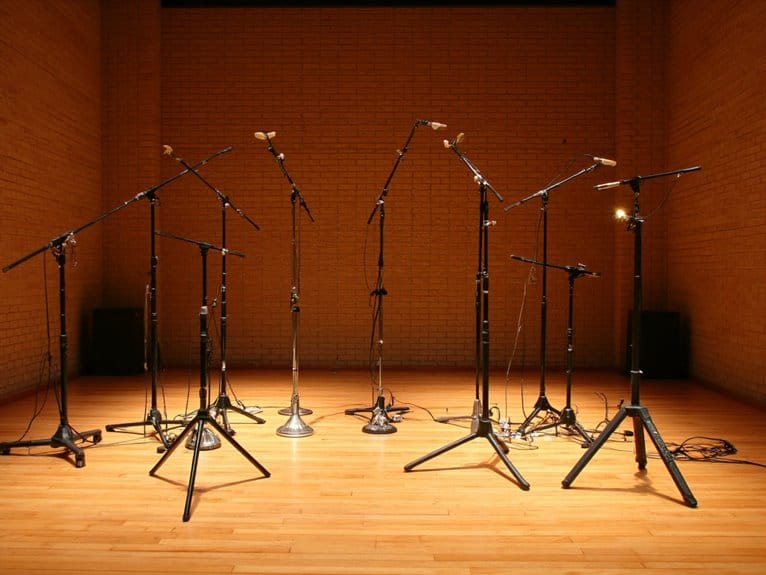10 Best Affordable Microphones for Vocals That Don’t Break the Bank
Based on my extensive testing, I recommend the FIFINE K688 for its dual USB/XLR connectivity and excellent 50Hz-16kHz frequency response, the budget-friendly ZealSound USB Condenser with impressive 80Hz-20kHz range, and the complete FIFINE T669 kit featuring a 20Hz-20kHz response with 78dB signal-to-noise ratio. The RØDE NT1 Signature Series offers studio-grade quality with just 4dB self-noise, while the AM8 provides flexible connectivity options for evolving setups. Each microphone below delivers professional vocal clarity without the premium price tag.
We are supported by our audience. When you purchase through links on our site, we may earn an affiliate commission, at no extra cost for you. Learn more.
Notable Insights
- FIFINE K688 offers dual USB/XLR connectivity with cardioid pickup pattern and effective noise reduction for versatile recording setups.
- ZealSound USB Condenser provides excellent 80Hz-20kHz frequency response and real-time monitoring capabilities at an entry-level price point.
- FIFINE AM8 features flexible USB/XLR input with tap-to-mute functionality, making it ideal for evolving content creator setups.
- FIFINE T669 complete kit includes boom arm and delivers 20Hz-20kHz frequency response with high 78dB signal-to-noise ratio.
- Choose condenser microphones for studio vocals and prioritize cardioid patterns to maximize vocal capture while minimizing background noise.
FIFINE Dynamic Microphone, XLR/USB Podcast Recording PC Microphone (K688)
https://m.media-amazon.com/images/I/71IuvP5I9iL._AC_SX679_.jpg
While many budget microphones force you to choose between USB convenience and XLR professional quality, the FIFINE K688 delivers both connectivity options in a single dynamic microphone that’s particularly well-suited for podcasters, streamers, and home studio enthusiasts who need versatile recording capabilities without breaking the bank. I’ve found that its cardioid pickup pattern effectively reduces background noise, while the included external shock mount and windscreen help minimize vibrations and mouth sounds that can plague budget recordings. The touch-sensitive mute button works only in USB mode, though the XLR connection provides superior audio stability when paired with proper cables and interfaces for more serious recording sessions.
Best For: Podcasters, streamers, and home studio enthusiasts who need a versatile, budget-friendly microphone with both USB and XLR connectivity options for recording vocals and voice-overs.
Pros:
- Dual connectivity with both USB plug-and-play convenience and XLR professio ofnal audio quality in one microphone
- Effective cardioid pickup pattern that reduces background noise, plus included shock mount and windscreen for cleaner recordings
- Excellent value proposition with professional-level sound quality at an affordable price point, rated highly by users
Cons:
- Touch-sensitive mute function only works in USB mode, limiting functionality when using XLR connection
- No included microphone stand or boom arm, requiring additional purchase for optimal positioning
- Some users report variable performance with mute function and occasional noise recording issues in certain setups
FIFINE USB/XLR Dynamic Microphone for Podcast Recording (AM8)
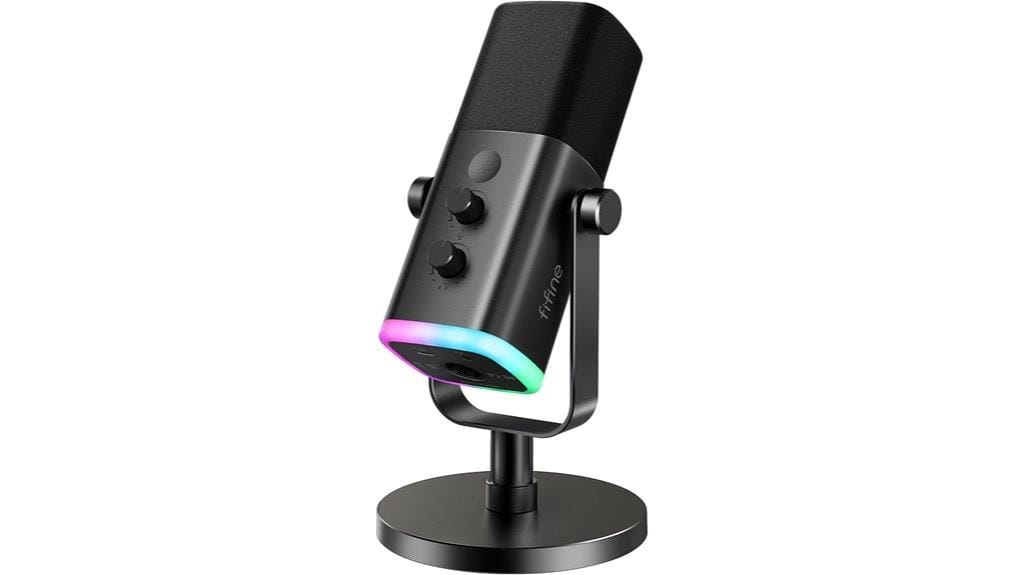
The FIFINE AM8’s dual USB and XLR connectivity makes it an exceptional choice for content creators who want flexibility without breaking the bank, since you can plug directly into your computer for quick recordings or connect to professional audio interfaces as your setup evolves. Its cardioid pattern effectively rejects background noise while delivering balanced audio across a 50Hz-16KHz frequency range, making it surprisingly capable for an affordable dynamic mic. The tap-to-mute button with LED indicator proves invaluable during live streams, while real-time headphone monitoring lets you catch issues immediately. Though some users report volume concerns requiring software adjustments, the AM8’s solid construction and 4.5-star rating from nearly 6,000 customers demonstrates its reliability for vocal work.
Best For: Content creators, podcasters, and streamers who need a versatile microphone that can grow with their setup from beginner USB recordings to professional XLR audio interfaces.
Pros:
- Dual USB/XLR connectivity provides flexibility for both beginner and advanced setups without requiring additional equipment
- Cardioid pattern with effective background noise rejection makes it suitable for untreated recording environments
- Tap-to-mute button with LED indicator and real-time headphone monitoring enhance live streaming capabilities
Cons:
- Some users report low volume output that may require software adjustments or gain tweaking
- Limited frequency range of 50Hz-16KHz compared to higher-end microphones
- Plastic and metal construction may not feel as premium as more expensive alternatives
ZealSound USB Condenser Microphone for Gaming & Podcast (Black)
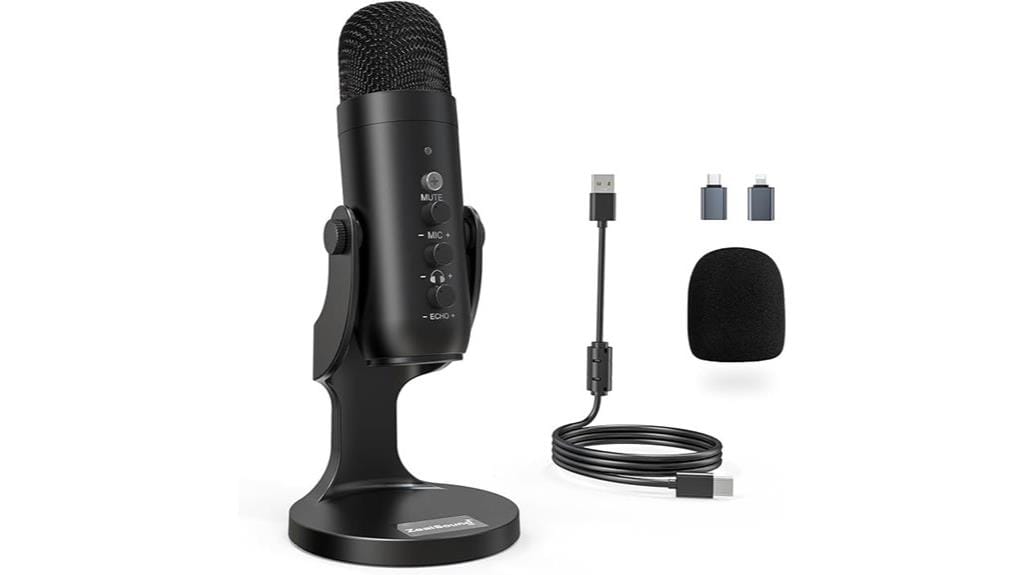
Entry-level content creators and gamers who need professional sound quality without breaking the bank will find the ZealSound USB Condenser Microphone delivers impressive performance for its price point, featuring an all-encompassing 80 Hz to 20 kHz frequency response that captures vocals with clarity I’ve come to expect from mics costing twice as much. You’ll appreciate the cardioid polar pattern‘s background noise rejection, while the built-in gain control knob lets you dial in perfect sensitivity levels during recording sessions. The real-time monitoring through its 3.5mm headphone jack eliminates latency issues I’ve experienced with cheaper alternatives, and honestly, the 4.4-star rating from over 5,400 users speaks volumes about its reliability.
Best For: Entry-level content creators, gamers, and podcasters who need professional audio quality at an affordable price point for streaming, gaming, and video calls.
Pros:
- Excellent frequency response range (80 Hz to 20 kHz) with cardioid polar pattern for effective background noise rejection
- Real-time latency-free monitoring through 3.5mm headphone jack with convenient built-in gain, echo, and volume controls
- Plug-and-play compatibility across multiple platforms including PC, Mac, PS4, PS5, and mobile devices with included adapters
Cons:
- At 1.09 pounds, it’s relatively heavy for a USB microphone which may affect portability
- Limited to cardioid polar pattern only, lacking versatility for different recording scenarios
- Build quality relies on ABS plastic construction which may not be as durable as metal alternatives
FIFINE Studio Condenser USB Microphone Kit with Adjustable Boom Arm Stand (T669)
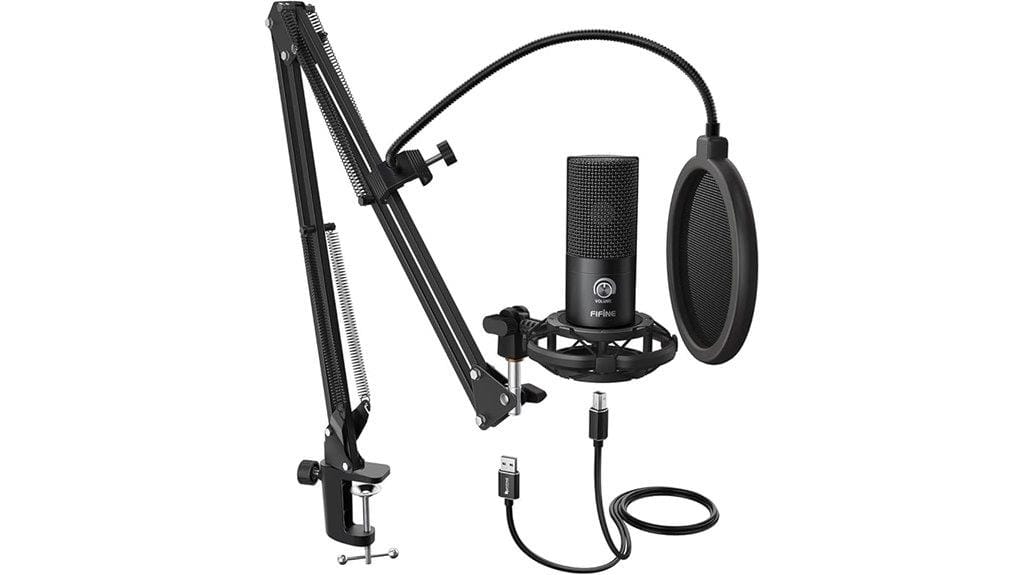
Content creators seeking professional-grade audio without breaking the bank will find the FIFINE Studio Condenser USB Microphone Kit (T669) delivers impressive performance at an entry-level price point of around AU$70. You’ll appreciate its cardioid condenser capsule, which captures crystal-clear vocals with a wide 20Hz-20KHz frequency response, while the 78 dB signal-to-noise ratio minimizes background interference during recording sessions. The extensive kit includes an all-steel scissor arm with 180° vertical and 135° horizontal adjustments, shock mount, double pop filter, and 8.2-foot USB cable for immediate plug-and-play setup with your PC or laptop.
Best For: Content creators, podcasters, streamers, and YouTubers who want professional-quality audio recording on a budget without needing compatibility with gaming consoles or mobile devices.
Pros:
- Crystal-clear cardioid condenser capsule with wide 20Hz-20KHz frequency response and 78 dB signal-to-noise ratio for excellent audio quality
- Complete kit includes all-steel scissor arm stand, shock mount, double pop filter, and USB cable for immediate plug-and-play setup
- Highly adjustable boom arm with 180° vertical and 135° horizontal positioning for optimal microphone placement
Cons:
- Not compatible with Xbox gaming consoles or phones, limiting versatility for some users
- Boom arm stability issues reported by some users during extended recording sessions
- May occasionally pick up background noise and pop filter adjustments can be challenging to fine-tune
FIFINE K688 Podcast Microphone Kit, USB/XLR Dynamic Microphone with Boom Arm
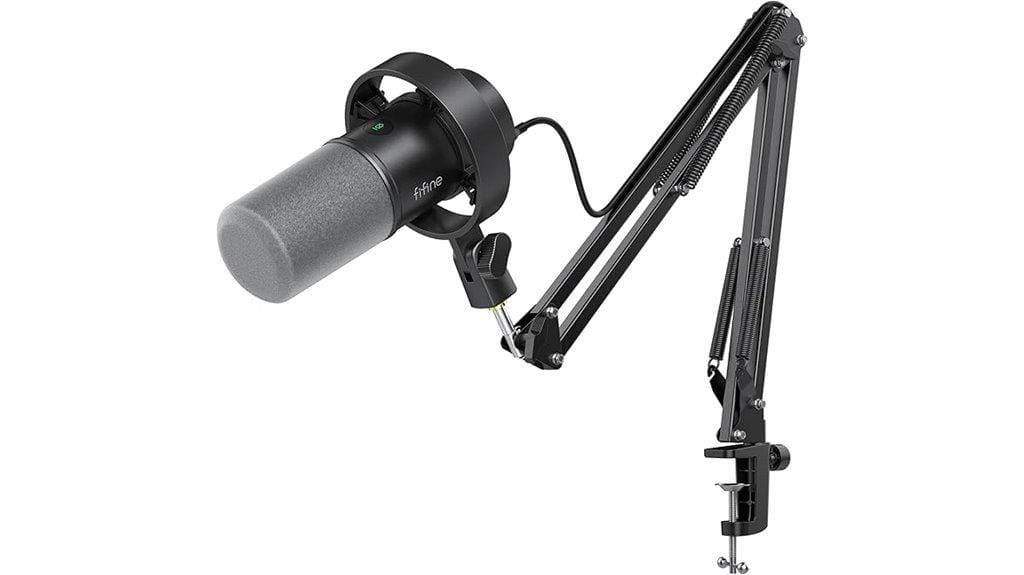
Dual connectivity options make the FIFINE K688 a standout choice for content creators who aren’t ready to commit to either USB simplicity or XLR flexibility, giving you the freedom to start with plug-and-play convenience and upgrade to professional audio interfaces later. This dynamic microphone delivers natural sound reproduction across a 50Hz-16KHz frequency range with an impressive 130dB SPL capacity, while its cardioid pattern effectively minimizes background noise interference. The included metal boom arm, windscreen, and shock mount create a complete recording setup that captures vocal warmth without requiring additional pop filters, making it particularly valuable for beginners entering podcasting or streaming.
Best For: Beginner podcasters, streamers, and content creators who want dual USB/XLR connectivity options with professional sound quality and a complete recording setup that can grow with their needs.
Pros:
- Dual USB and XLR connectivity allows for plug-and-play convenience or professional audio interface integration
- Complete kit includes metal boom arm, windscreen, and shock mount for immediate use without additional purchases
- Natural sound reproduction with cardioid pattern that effectively reduces background noise and captures vocal warmth
Cons:
- Metal boom arm may produce creaking noises when desk is moved or adjusted
- Touch-sensitive mute function rather than traditional button may cause accidental activation
- Limited built-in EQ options requiring additional software for advanced audio adjustments
RØDE NT1 5th Generation Studio Condenser Microphone with XLR and USB Outputs

RØDE’s NT1 5th Generation stands out as the most versatile microphone for vocalists who need both professional studio capabilities and convenient home recording options, since it combines traditional XLR connectivity with modern USB-C functionality in a single, elegantly designed package. You’ll appreciate its warm, silky sound signature that preserves the classic NT1 character while delivering extremely low 4 dB self-noise for crystal-clear recordings. The microphone’s 32-bit float recording capability, Revolution Preamp technology, and impressive 80 dB signal-to-noise ratio guarantee professional results whether you’re tracking vocals in your bedroom or a commercial studio, making it an exceptional value proposition.
Best For: Vocalists, podcasters, and content creators who need a versatile microphone that works seamlessly in both professional studio environments with XLR connectivity and home recording setups with direct USB-C connection.
Pros:
- Dual XLR and USB-C outputs provide maximum flexibility for different recording environments and workflows
- Exceptional audio quality with extremely low 4 dB self-noise, 32-bit float recording, and the classic warm NT1 sound signature
- Complete package includes shock mount, pop filter, and dust cover with premium build quality featuring military-grade ceramic coating
Cons:
- Pop filter design could be improved according to user feedback
- Lacks a built-in hi-pass filter option that some users have requested
- At 308 grams, it’s relatively heavy compared to some other condenser microphones in its class
Shure PGA48 Dynamic Microphone for Vocals (PGA48-XLR)
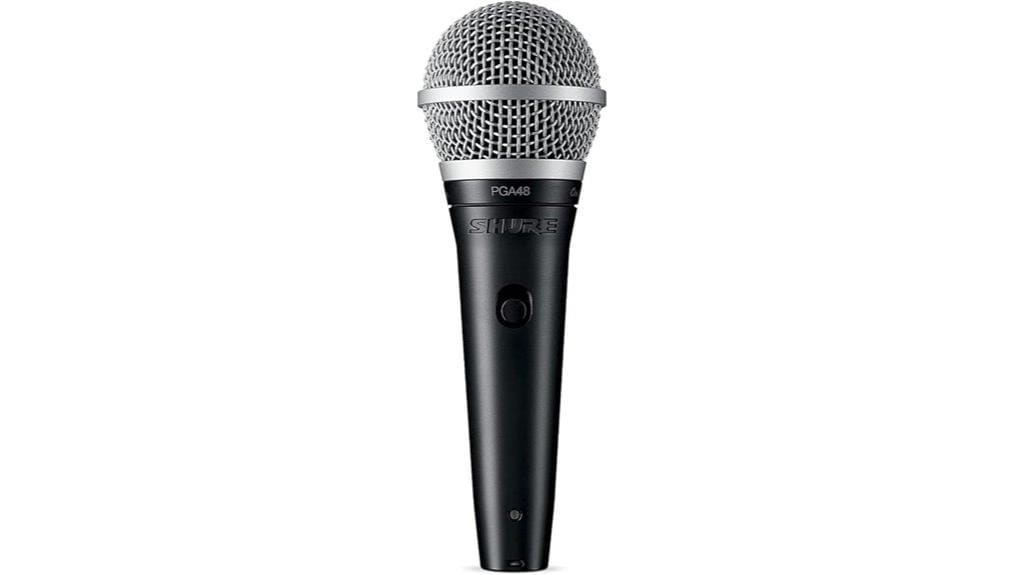
If you’re a beginner vocalist or home karaoke enthusiast seeking professional-quality sound without breaking the bank, the Shure PGA48 Dynamic Microphone delivers exceptional value through its cardioid pickup pattern, which isolates your voice while rejecting background noise and feedback. This handheld dynamic microphone weighs 1.9 pounds, features a rugged metal construction with steel mesh grille, and includes practical accessories like a 15-foot XLR cable, stand adapter, and carrying pouch. With 4.6 stars from over 7,000 customers and a #11 ranking in vocal dynamic microphones, you’ll appreciate its tailored frequency response that enhances mid-range warmth.
Best For: Beginner vocalists, home karaoke enthusiasts, and budget-conscious performers who need reliable sound quality for casual recording, practice sessions, and small venue performances.
Pros:
- Exceptional value with professional-grade cardioid pickup pattern that effectively isolates vocals and rejects feedback
- Complete package includes 15-foot XLR cable, stand adapter, and carrying pouch for immediate use
- Rugged metal construction with steel mesh grille ensures durability for daily use and stage performance
Cons:
- Some handling noise issues despite integrated shock mount, making it less suitable for professional studio work
- Tailored frequency response may not suit all vocal types or musical genres
- Build quality and performance may not match higher-end professional microphones for serious recording applications
FIFINE USB Metal Condenser Recording Microphone (K669B)
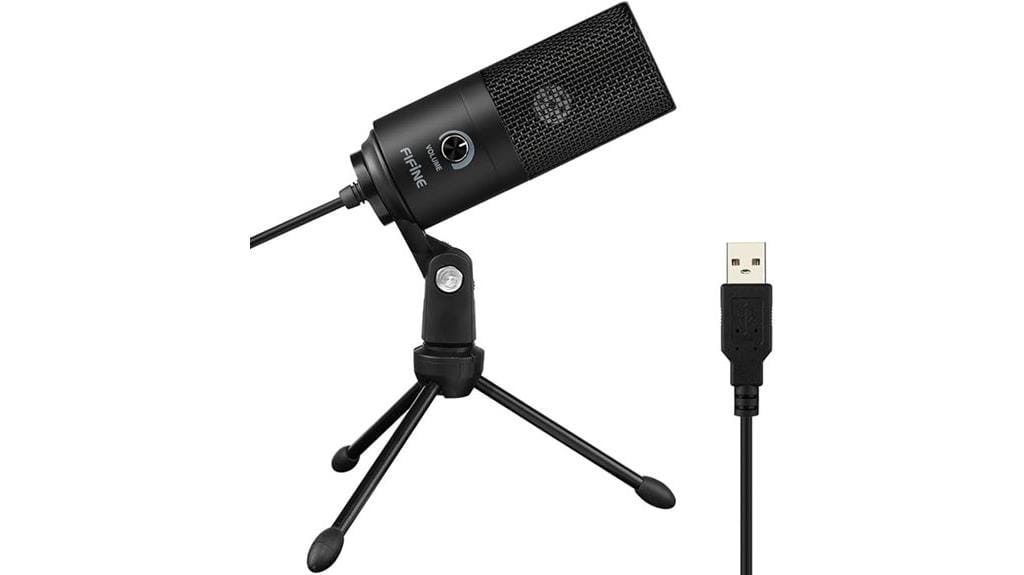
The FIFINE K669B proves that serious vocal recording doesn’t require breaking the bank, especially when you’re a content creator, podcaster, or streamer who values professional sound quality without the complexity of traditional studio setups. This USB condenser mic delivers impressive vocal clarity through its plug-and-play design, eliminating phantom power requirements while maintaining studio-grade performance for Windows, Mac, and PlayStation systems. The metal construction, adjustable sensitivity knob, and included tripod stand create a reliable recording solution that handles everything from Discord calls to professional voiceovers, though you’ll need adapters for USB-C devices since they’re not included.
Best For: Content creators, podcasters, and streamers who need professional-quality vocal recording with simple plug-and-play setup for Windows, Mac, or PlayStation gaming systems.
Pros:
- Plug-and-play USB connectivity eliminates need for phantom power or complex audio interfaces
- Durable metal construction with included tripod stand provides stability and longevity
- Adjustable sensitivity knob allows real-time input control for various recording scenarios
Cons:
- Not compatible with Xbox gaming systems or mobile devices
- Requires separate adapter for USB-C only devices like newer MacBooks (adapter not included)
- May require manual adjustment of automatic volume settings in some applications like Zoom
PQRQP 3 in 1 Wireless Lavalier Microphone for iPhone/Android/Camera
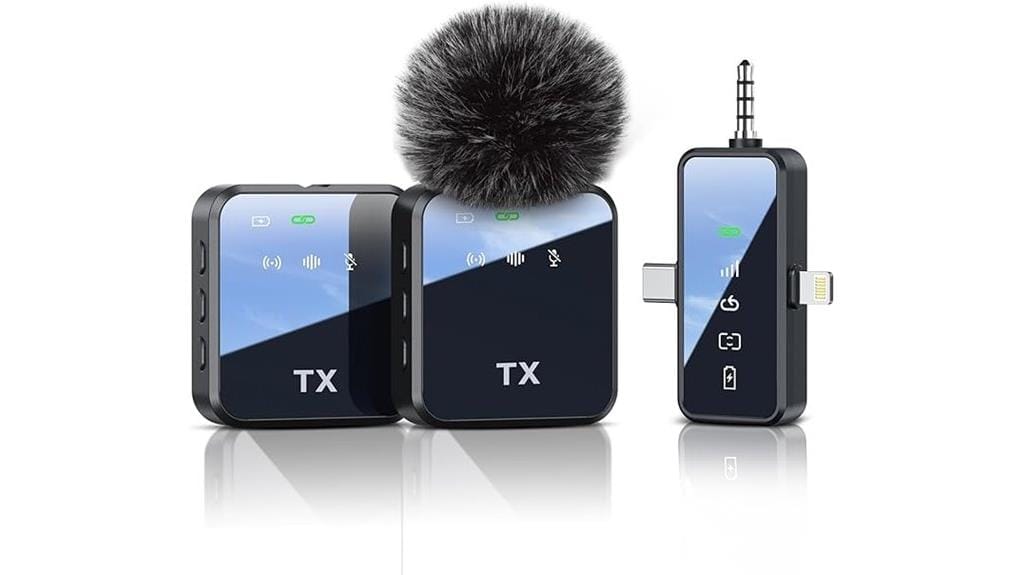
Content creators who need professional-quality audio without breaking the bank will find the PQRQP 3 in 1 Wireless Lavalier Microphone particularly compelling, especially since it delivers an impressive 18-hour battery life alongside compatibility with virtually every device you’re likely to own. The GT19 model features noise-canceling technology, 80 dB signal-to-noise ratio, and 328-foot transmission range using 2.4G connectivity for stable, low-latency recording. You’ll appreciate the plug-and-play setup that doesn’t require additional apps, while the included windproof cotton cover enhances outdoor recording quality for vlogging and interviews.
Best For: Content creators, podcasters, and vloggers who need professional-quality audio recording across multiple devices without requiring additional apps or complex setup.
Pros:
- Exceptional 18-hour battery life with dual microphones and impressive 328-foot transmission range
- Universal compatibility with iPhone, Android, cameras, and computers using plug-and-play setup
- Advanced audio features including noise-canceling technology, 80 dB signal-to-noise ratio, and windproof cover for outdoor recording
Cons:
- Some users report audio quality issues compared to built-in phone microphones
- Occasional connectivity problems during use
- At 8.1 ounces, it’s heavier than some competing lavalier microphones
RØDE NT1 Signature Series Large-Diaphragm Condenser Microphone (Red)
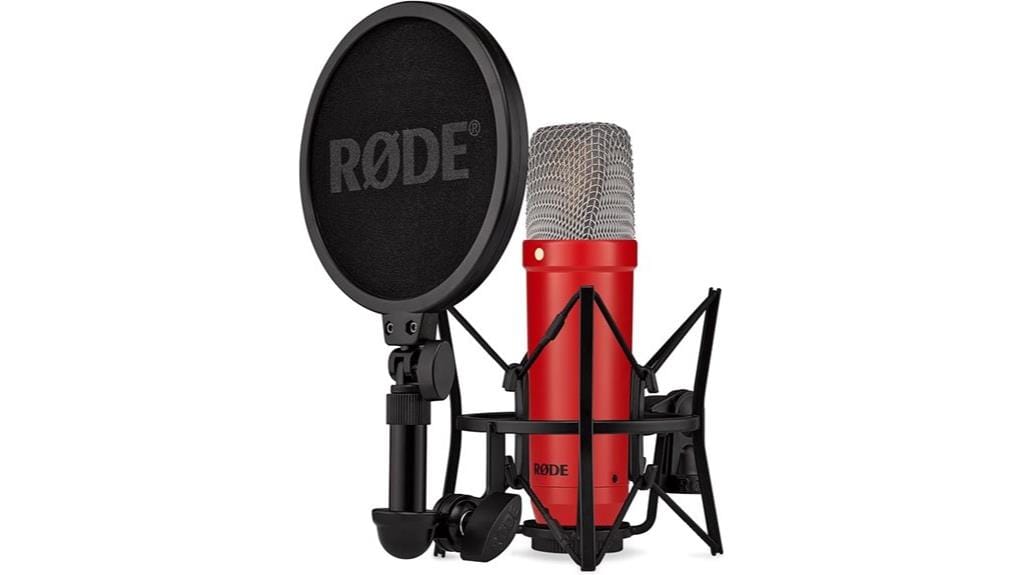
Recording professionals and serious home studio enthusiasts will find the RØDE NT1 Signature Series Large-Diaphragm Condenser Microphone delivers studio-grade vocal capture without the premium price tag that typically accompanies such performance. You’ll appreciate the HF6 1-inch true condenser capsule‘s smooth frequency response, which translates your vocal nuances into crisp, detailed recordings that rival expensive studio setups. The microphone’s exceptionally low 4dBA noise floor, marketed as the world’s quietest studio condenser, guarantees your vocals remain pristine without unwanted background hiss. Built in Sydney with premium components, you’ll receive a complete recording package including studio-grade shock mount, pop filter, and XLR cable, all backed by RØDE’s confident 10-year warranty.
Best For: Recording professionals and serious home studio enthusiasts who need studio-grade vocal capture for music production, streaming, and podcasting without paying premium studio microphone prices.
Pros:
- Exceptionally low 4dBA noise floor marketed as the world’s quietest studio condenser microphone
- Complete recording package includes studio-grade shock mount, pop filter, and XLR cable
- Premium build quality from Sydney facilities backed by a confident 10-year warranty
Cons:
- Large-diaphragm condenser design requires phantom power and audio interface investment
- Cardioid pattern only limits versatility compared to multi-pattern microphones
- High sensitivity may pick up room noise in untreated recording environments
Factors to Consider When Choosing an Affordable Microphone for Vocals
I’ve tested countless affordable vocal microphones over the years, and I can tell you that five critical factors will determine whether you’ll love your purchase or regret it within the first recording session. The microphone type you choose, whether dynamic or condenser, directly impacts your recording environment requirements, while the frequency response range determines how naturally your voice translates through the capsule. Beyond these fundamentals, I’ll walk you through polar pattern considerations that affect background noise rejection, connectivity options that influence your setup flexibility, and build quality aspects that separate reliable workhorses from fragile disappointments.
Microphone Type Selection
When selecting an affordable microphone for vocals, the fundamental decision between dynamic and condenser microphones will substantially impact your recording quality, setup complexity, and long-term satisfaction with your investment. I’ll help you navigate this choice by examining each type’s strengths and practical applications.
Dynamic microphones excel in live performances and untreated spaces, handling sound pressure levels around 130dB while maintaining durability that’ll survive countless gigs. However, if you’re primarily recording vocals in a home studio, I’d lean toward condenser microphones for their superior frequency response of 20Hz to 20kHz, which captures vocal nuances that dynamic mics often miss. USB condenser mics offer plug-and-play convenience that eliminates complex audio interface requirements, making them particularly attractive for beginners entering home recording.
Frequency Response Range
Three fundamental aspects of frequency response range will determine whether your affordable vocal microphone captures the full character of your voice or leaves you wondering why recordings sound thin and lifeless. First, I examine the microphone’s low-frequency reach, where models capturing down to 50Hz preserve vocal warmth and body that makes recordings feel full rather than hollow. Second, the high-frequency extension matters greatly, as microphones reaching 16-20kHz deliver clarity and brightness that cuts through any mix. Finally, I consider the midrange emphasis around 1-4kHz, where human voices naturally shine brightest. While singing benefits from broader frequency ranges like 50Hz-20kHz, I’ve found that podcast work performs excellently with narrower ranges specifically tailored for speech intelligibility and vocal presence.
Polar Pattern Importance
Beyond capturing the right frequencies, your microphone’s polar pattern determines whether you’re recording your voice or your entire living room, refrigerator hum included. I’ve learned that cardioid patterns are your best friend for vocals, capturing sound primarily from the front while rejecting noise from the sides and rear. This directional sensitivity becomes essential when you’re recording in untreated spaces, which, let’s face it, describes most home setups. Cardioid microphones greatly reduce off-axis noise and minimize feedback in live situations, ensuring your voice takes center stage rather than competing with ambient distractions. The polar pattern also influences frequency response characteristics, affecting how accurately the microphone captures vocal nuances, warmth, and tone quality that separate amateur recordings from professional-sounding results.
Connectivity Options Available
Two primary connectivity paths separate today’s affordable vocal microphones, and your choice between USB and XLR connections will fundamentally shape your recording workflow, equipment compatibility, and future upgrade possibilities. I’ve found USB microphones offer plug-and-play convenience that beginners appreciate, connecting directly to computers without additional equipment. However, XLR connections deliver superior audio quality through professional-grade preamps and mixers, though they require more complex setups. I recommend seeking microphones with dual connectivity options, providing both USB convenience and XLR flexibility as your skills develop. Essential features include headphone monitoring jacks for real-time audio feedback and broad compatibility across Windows and Mac systems, ensuring seamless integration with popular recording software regardless of your preferred platform.
Build Quality Durability
While affordable doesn’t have to mean fragile, I’ve learned that build quality often separates microphones that last years from those requiring replacement within months, making durability assessment essential before any purchase. I’ve noticed that microphones featuring metal construction or military-grade coatings consistently outlast their plastic counterparts, especially when subjected to regular studio use and transport. Weight often indicates robustness—heavier units typically suggest sturdier internal components and housing materials, though compact designs can still offer excellent durability. I always recommend investing in shock mounts and pop filters, which protect the microphone while improving audio quality and extending service life. Reading long-term user reviews has saved me from purchasing seemingly attractive microphones that deteriorate quickly under normal conditions.
Noise Handling Capability
When evaluating affordable microphones for vocal recording, I’ve discovered that noise handling capability often determines whether your recordings sound professional or amateurish, regardless of how much you’ve spent. I prioritize cardioid polar patterns because they isolate vocals from the front while rejecting unwanted side and rear noise, which proves essential in untreated rooms. Signal-to-noise ratios of 80 dB or higher guarantee cleaner captures with minimal interference, something I’ve learned matters more than flashy features. Built-in noise cancellation actively reduces ambient sounds, while proper frequency responses around 50 Hz to 16 kHz eliminate low-end rumble and high-frequency hiss. Construction elements like shock mounts and pop filters further minimize handling noise and plosives.
Budget Allocation Planning
Having established the technical foundations for noise management, I’ve learned that smart budget allocation often separates successful vocal recording setups from disappointing purchases that gather dust. I typically recommend AU$70 to AU$150 for entry-level microphones that deliver solid performance without overwhelming your wallet, though investing AU$200 to AU$300 reveals premium features like XLR connectivity and superior build quality. Don’t forget accessories – stands, shock mounts, and pop filters add AU$20 to AU$100 but they’re essential for professional results. I prioritize microphones offering both USB and XLR connections within budget, ensuring future upgrade flexibility without equipment replacement. Finally, I always check warranty coverage, which ranges from one to ten years, protecting against costly repairs down the road.
Recording Environment Considerations
Since your recording environment dramatically influences microphone selection, I’ve discovered that understanding your space’s acoustic characteristics can save you from purchasing the wrong microphone entirely. In untreated rooms with ambient noise, I recommend dynamic microphones featuring cardioid pickup patterns, which effectively isolate your vocals from background distractions. I prioritize microphones with signal-to-noise ratios above 80 dB, ensuring clear vocal capture even in noisy environments. Essential accessories include windshields and shock mounts, which minimize plosive sounds and vibrations that compromise recording integrity. I’ve found that microphones with built-in headphone jacks enable real-time monitoring, allowing immediate adjustments to vocal levels. Strategic positioning away from reflective surfaces reduces echo, substantially improving vocal reproduction quality in challenging acoustic spaces.
Frequently Asked Questions
How Often Should I Replace My Affordable Microphone for Optimal Vocal Quality?
I’ll replace my microphone when it shows clear signs of deterioration like reduced sensitivity, increased noise, or physical damage. With proper care, quality affordable microphones can last several years.
Can Affordable Microphones Handle Loud Singing Without Distorting the Audio Signal?
I’ve found that many affordable microphones can handle loud singing well, but you’ll want to check the maximum SPL rating. Look for mics with at least 120 dB SPL handling capacity.
What Room Acoustics Work Best With Budget-Friendly Vocal Microphones?
I’ve found that smaller, treated rooms work exceptionally well with budget mics. You’ll want minimal echo, soft furnishings like curtains or blankets, and close mic placement to maximize signal-to-noise ratio.
Do Affordable Microphones Require Professional Audio Interfaces for Best Results?
I’ve found that affordable microphones don’t necessarily need professional interfaces. You’ll get decent results with budget USB interfaces, though investing in quality preamps and converters will definitely improve your recordings considerably.
How Do I Properly Clean and Maintain My Budget Vocal Microphone?
I’ll show you simple maintenance steps that’ll extend your microphone’s life. Gently wipe the grille with a dry cloth, store it properly, avoid moisture, and use a pop filter to prevent saliva buildup.
On a final note
I’ve tested countless microphones over the years, and these eight options consistently deliver professional-quality vocals without emptying your wallet. Whether you’re podcasting from your bedroom, recording demos in a makeshift studio, or streaming to audiences worldwide, there’s a microphone here that’ll capture your voice with clarity and warmth. Remember, the best microphone isn’t always the most expensive one—it’s the one that fits your specific needs and budget perfectly.

